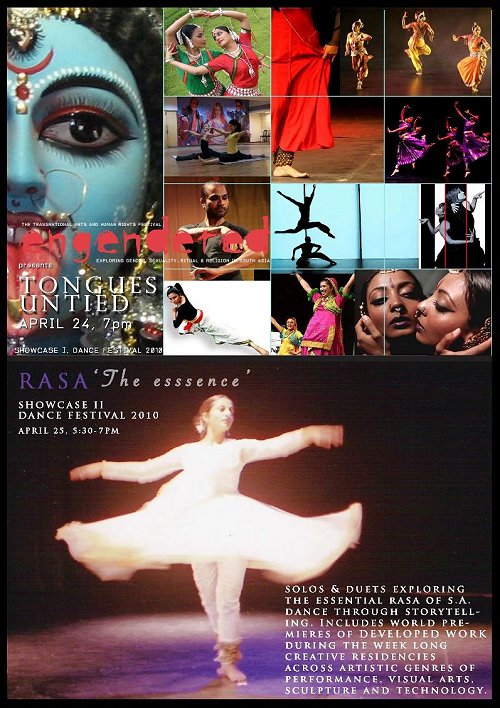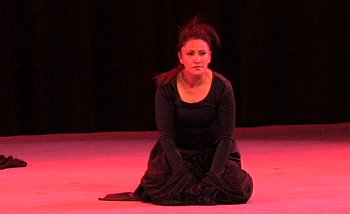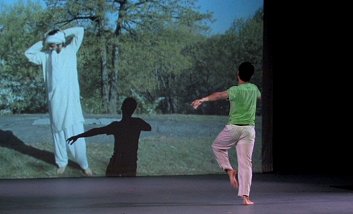
|   |

|   |
Engendered Dance Festival, New York, April 20-25, 2010 e-mail: sunilkothari1933@gmail.com July 29, 2010 No sooner did I arrive in New Delhi on 18th April from Beijing, after attending the inauguration of the Festival of India in China with Ratan Thiyam's Chorus Repertory Theatre, who presented the play Uttar Priyadarshi, then I took off to New York by Qatar Airways, arriving just in time at Clark Studio at Lincoln Centre on 20th April to attend the panel discussion and the press conference organized for Engendered Dance Festival. Myna Mukherjee, the Director of the Festival, was asking a few questions and the participants were narrating their histories, how they came to the field of dance and their experiences.  Previous year during the Engendered "I View" Film Festival, I had seen Myna conducting similar discussions with aplomb and as a seasoned panelist, engaging members on panel and audience involved in discussion. She has an ability to put the speaker completely at ease and she inspires confidence in him/her to share personal narratives. From among the participants, since I came late, I could catch up with Kathak dancer Nighat Chaodhry from Pakistan, young painter Raghava KK, and finally Uttara Asha Coorlawala, who spoke on body in dance and referred to subtle bodies and yoga. Nighat's story was quite moving. During her childhood, her father used to extend corporeal punishment. Born in London, Nighat studied classical ballet, modern dance and started studying Kathak under the legendary dancer Nahid Siddiqui, who lived for many years in Birmingham and London. When she went to Lahore in Pakistan, Nighat found that it was not easy to dance there. During the time of President Zia, dance was banned. That was the worst regime for the performing arts like dance. Addressing issues of LGBT community, an acronym for Lesbian, Gay, Bisexual and Transgender, the Engendered Dance Festival was designed not only to raise awareness, but also "to act as a fulcrum to enter public dialogue, break silences and impact perceptions around issues of gendered identities, how those issues relate to affirmation or violation of human rights, health rights and women's rights." Such a festival is so far not held in India. I suggested that Myna having taken such an initiative, should take a lead to organize a similar festival in India. With the recent High Court order about the same sex love in India, the climate would be favourable to organize such a festival and panel discussions. The tolerance displayed by the 'Tam Bam' die-hard dancers like Kalanidhi Naryanan and Krishna Gana Sabha, in Chennai, accepting Bharatanatyam dancer Narthaki Nataraj, a disciple of Kitappa Pillai, is an indication of liberal attitude. Though I am not sure how society would take to someone exceptionally gifted like Bijli, a Pakistani transgender 'drag queen,' who performs for elite, rich patrons in New York, who absolutely adore her.
I went with Myna and other artists to Philadelphia next morning. During the car ride, we had a lot of discussion about the current practice of performances, the mujra by the baijis and tawaifs, what we see in Mumbai masala films, the relevance of classical Indian dances, why dancers perform in dwindling market all over India. There are visibly fewer and fewer persons to take time off from their routine jobs to assist either the husband or the spouse in each one's pursuit of academics, studies or dance. But I could have been less pessimistic. The dancers I know all have complete support from their husbands, members of their families and so many friends. The Penn Museum Auditorium architecture has an old world charm and is quite spacious. But alas, it is not well maintained and looked like those in charge do not love it. The coordinators had perhaps not realized that the performing arts required certain facilities, in particular when dance was to be presented. Therefore, the performances also looked lackluster. The event was not well advertised, therefore the audience attendance was very poor. Myna said that it was to make a breakthrough that the program was organized at Penn Museum by South Asia Center by Assistant Director Riali Roy and Kathak exponent Prof Pallavi Chakravorty of Swarthmore College. The announcements were made by Myna and I was asked to introduce two dancers of Pakistani origin. The program began with Bijli's rendering of a Sufi composition. Dressed in a bluish costume with clusters of shining sequins, she performed with sincerity, but I was not impressed. It looked a routine performance whereas at Symphony Space, she was outstanding, though some of the members of the audience knew nothing about her. More about her performance at Symphony Space later on.   This brings me to my interest and reaction to dancers from Pakistan. I called Nahid Siddiqui who has moved to Houston, Texas from Pakistan, to settle down there, teaching and performing, to join us for the festival at Symphony Space. But she said that she would in future and not at such a short notice. I had seen her in November, last year at World Dance Alliance Asia Pacific conference in New Delhi which we had arranged under India Chapter registered as a society of Dance Alliance. She had performed a brief piece in Kathak to recorded music at the Habitat. It was so dignified and exquisite that one wanted to see more of her Kathak dance. When my book on Kathak was published, I had no access to her photographs to include in exponents section. She was also very unhappy that she was not included. I met her in London at Bharatiya Vidya Bhavan, where she had taught for a while. I have seen her perform at Purcell Room on South Bank in London. She lived in Birmingham for many years and divided her time between Lahore and Birmingham, teaching and training young dancers - among them Sonia Sabri is outstanding. The lasting impression she made was during Kalanidhi Arts Foundation of Sudha Khandwani's New Directions in Indian Dance conference in February 1993 at Toronto, where she not only had performed Kathak but also rendered thumri, as she is a gifted singer. Subodh Rathod in London had loaned me her documentary of BBC, directed by her former husband Zia Moinuddin, which has a duet, a tarana in Bageshri raga, with that Adonis among dancers, late Durgalal. Ah, what chemistry they had and what magic has been captured on video, which enthralls one even today when one sees their duet. Both Nighat Chaodhry and Shayma Saiyidi have studied under Nahid for some time in Pakistan and also in London. But when Nighat and Shayma performed brief pieces in Kathak, it did not appear substantial. Their Kathak did not seem to have strength as they presented at Penn Museum. But when Nighat performed the 'Purdah' at Symphony Space, I sat up and responded to the content and also to the technique. Nighat within the context of Islamic country, questions the Purdah upon a woman, where her house, her chaddar, her burqua, society or religious doctrine confines her. Even with all these restrictions, she is still invaded and violated. Her realization that why is she the only one who is made to believe that it is just her responsibility. What about the veil of heart, the eyes of the society? She questions the purdah outside and the purdah inside. In a gesture of rebellion, she throws the purdah to the audience. It was a very moving and bold work. Nighat has performed it in Pakistan. That confused me. Is dance allowed in Pakistan? In public spaces? She said that she has given several performances in Pakistan, when she was very close to Benazir Bhutto. Now she lives in Lahore. She has performed in Karachi in dance drama Heer, in 'Faiz Ahmed Faiz' mela, in first National Dance Festival in Pakistan, for fund raiser for Cancer Society in many cities in Pakistan. She has appeared on TV and also in serials. Very active, she performs internationally and seems she has not many difficulties in carrying on her dance activities in Lahore. Shayma Saiyidi lives in New York. When we gave a lecture on Kathak showing difference between Lucknow and Jaipur gharana at Bernard College, coordinated by Uttara Asha Coorlawala, Nighat and Shayma demonstrated what they had studied under Nahid and also Gulam Hussain Maharaj. Rajiv Purohit and Manasi, two Kathak dancers of Sambhaav Dance Project showed Jaipur gharana features along with Rachana Ramya, trained in Jaipur Gharana, now settled in Connecticut. The lamchhad parans of Jaipur gharana in contrast to graceful movements of Lucknow gharana along with several pure dance pieces, intra forms were demonstrated clearly. Dance in Pakistan
An interesting aspect of this demonstration co-coordinated by Uttara Asha Coorlawala was, what is the state of dance in Pakistan? In Sruti monthly published from Chennai, issue 146 November 1996, Tehreema Mitha, who also participated in Engendered Dance Festival wrote an article which categorically stated that in public spaces, classical Indian dance was not encouraged for presentation, though Quran does not say that dance cannot be performed. Not having read Quran for factual evidence, I cannot say what Quran dictates. But it is true that dance in public places is not encouraged. During President Zia's regime, it was completely banned. What dancers like Nighat Chaodhry do is that they could perform because some of them, like Nighat, were close to Benazir Bhutto. However, when I asked Bangladesh participants in WDA global assembly, they said that dance is allowed to be performed in public spaces. Guru Bipin Singh's disciple Tamanna Rahman, who stayed in Guruji's residence in Kolkata, where I also was staying, told me When I went to Dhaka to establish Bangladesh chapter, I saw many enthusiastic performing groups and performances were held in my honour at many public spaces, auditoriums. Luckily, Mrs. Veena Sikri was the High Commissioner there at Dhaka, and a lot of concessions were accorded to performing artists like Madhavi Mudgal and Alarmel Valli, to cite two major dancers from India, who were presented in a public auditorium. (To be concluded in next installment)  Dr. Sunil Kothari, dance historian, scholar, author, is a renowned dance critic, having written for The Times of India group of publications for more than 40 years. He is a regular contributor to Dance Magazine, New York. Dr. Kothari is a globetrotter, attending several national, international dance conferences and dance festivals. He has to his credit more than 14 definitive works on Indian classical dance forms. Kothari was a Fulbright Professor and has taught at the Dance Department, New York University; has lectured at several Universities in USA, UK, France, Australia, Indonesia and Japan. He has been Vice President of World Dance Alliance Asia Pacific (2000-2008) and is Vice President of World Dance Alliance Asia Pacific India chapter, based in New Delhi. A regular contributor to narthaki.com, Dr Kothari is honored by the President of India with the civil honor of Padma Shri and Sangeet Natak Akademi award. He recently received the Senior Critic award from Dance Critics Association, NYC. |